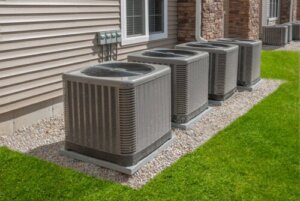Aerothermal Energy: What Is It, How Does it Work, and What Are its Advantages?

There is a more ecological alternative to common heating and cooling systems. Aerothermal energy is a technology that allows heat pumps to harness the energy of the air for their operation. In this way, its system makes it possible to obtain heat from the ambient air, even at low temperatures.
This is a technology that’s easy to install and simple to use, among other advantages. Thanks to its energy efficiency, it’s more commonly used in large structures, such as airports or hospitals. However, more and more homes are using it to supply radiant floors and domestic hot water.
What is aerothermal energy?
Aerothermal energy is a technology that uses air energy to produce heat and cooling. It’s generated through the use of heat pumps, which extract energy from the external air to heat a room.
Meanwhile, to cool a space, the circuit is activated in reverse. In this way, aerothermal energy uses the energy found in the air for air conditioning.
Where is it used?
The use of air as an energy source makes it an environmentally friendly technology compared to other heating systems. However, its initial investment is usually more expensive. For some time now, this mechanism has been used for air-conditioning circuits installed in large buildings. In general, they do this through the laying of underfloor heating.
For example, in airports, offices or hospitals, it’s quite common. However, due to its energy efficiency, it’s increasingly in demand in family homes and residential buildings. Thanks to heat pumps that work with aerothermal energy, it’s possible to achieve cooling, heating, and domestic hot water.

How aerothermal energy works
The general operation of this energy is simple. A circuit that extracts heat from the outside air is generated from two units that make up the heat pumps, one that’s external and one that’s internal.
The unit in charge of this step is the evaporator. It then injects this heat into the environment through the unit called the condenser.
The basis of aerothermal operation is in the refrigerant circuit, which connects the internal and external units. Through this circuit, the internal fluid changes temperature and state during several instances. It goes through a gaseous process, a liquid process, a heat process, and finally, a cold process.
After four phases, the cold gas is expelled to the outside. Meanwhile, heat enters through the radiant floor.
A key device for this transformation is the compressor. It uses electrical energy to increase the temperature during the initial phase.
On the other hand, the same aerothermal system can generate cold air. To do this, it inverts the refrigeration circuit, expelling the hot air out and injecting the low-temperature air inside.
We think you may also enjoy reading this article: Five Tricks to Brighten Dark Spaces without Electricity
Types of heat pumps
There are different types of heat pumps, among which are those that use aerothermal energy. They’re divided according to the external and internal medium with which the machine exchanges heat:
- Air-to-air pump: This takes heat from the outside air and transfers it directly to the inside. It’s used by split systems of air conditioners.
- Air-water pump: In this case, heat is extracted from the air and injected into a water circuit that supplies the radiant ceilings or floors, radiators, or fan heaters.
- Water-air pump: Contrary to the previous case, heat is extracted from water deposited on the ground or in the river and then transferred to the internal air.
- Water-to-water pump: Heat is extracted from the water, as in the previous case, but then transferred to another water circuit.
The advantages of aerothermal energy
Like any heating or cooling system, aerothermal has its advantages and disadvantages. However, there are many reasons to turn to this new, more environmentally friendly technology.
Little waste
Many people choose aerothermal technology because of its easy installation, since it doesn’t require a chimney for smoke exhaust. This is because it doesn’t require combustion, so cleaning isn’t necessary, nor is it prone to the generation of dirt or debris. In addition, the lack of fuel contributes to the home’s safety.
The energy use of aerothermal energy
One of the main advantages of this technology is that it reduces energy use, because most of the resources are extracted from the outside air. However, a quarter of the circuit uses electrical energy, which is generally more expensive than gas. Although this is a low percentage, it still has its advantages.
Single-source energy
Other heating and cooling systems often use combined energy systems. That is, they often use a combination of gas, electricity, or diesel.
This situation can generate disadvantages, depending on the geographical area where it’s located. It’s also subject to the conditions of two different utilities. Aerothermal pumps, on the other hand, only depend on one electrical source.
Ease and unity of use
Aerothermics works with a common generator for all its uses. That is, they work for heating, cooling, and domestic hot water. This is an advantage in terms of space utilization. It’s also easier to maintain.
Environmentally friendly
With regard to the environmental issue, aerothermal technology has the advantage of not producing direct carbon dioxide emissions. However, it does produce pollution by using electrical energy.
However, its emissions are much lower than other heating or cooling systems. In addition, these sources could come from renewable energies.

The disadvantages of aerothermal energy
Although it is a new technology with many ecological advantages, some disadvantages must also be taken into account.
Higher investment
The main disadvantage of this air-conditioning system is that it requires a much larger initial investment than other technologies. However, it’s possible to recover a part of it thanks to the lower energy consumption of the device.
Geographical space
By using air energy as the main source, external climatic conditions have a direct influence on its operation. This means that the lower the external temperature, the less efficient the aerothermal heat pump will be.
This type of energy is not recommended for geographical spaces characterized by temperatures below 0 degrees Celsius.
External space
The aerothermal heat pump requires an external space where to place one of its main units. This situation implies a greater visual impact than that of an air conditioner.
Like this article? You may also like to read: 5 Tips to Protect the Skin Against the Effects of Air Conditioning
Evaluate all aspects before choosing aerothermal energy
Aerothermal technology is highly recommended at the time of construction or renovation of a house. Its easy installation and complementation with other air conditioning systems make it adaptable to different conditions. In addition, the internal unit produces very low sound, making it more comfortable, as well.
However, it’s important to take into account several aspects. For example, the initial investment and the geographical conditions of the place where you want to install it. Overall, it’s necessary to evaluate each particular situation.
All cited sources were thoroughly reviewed by our team to ensure their quality, reliability, currency, and validity. The bibliography of this article was considered reliable and of academic or scientific accuracy.
- Gentile, Alberto G. et al. “La Aerotermia Como Alternativa Para El Control de Triatoma Infestans (Hemiptera, Reduviidae) Resistentes a Deltametrina.” Cadernos de Saúde Pública 20.4 (2004): 1014–1019. Disponible en: https://doi.org/10.1590/s0102-311×2004000400016
- Carbonell-Morales, Tania , Gorozabel-Chata, Francis-B. , Actualidad y perspectivas de una bomba de calor de expansión directa con energía solar. Ingeniería Mecánica [Internet]. 2016;19(1):49-58. Recuperado de: https://www.redalyc.org/articulo.oa?id=225144432006
- Solano, Juan Carlos, and Lorenzo Olivieri. “Climatización Eficiente Mediante Bombas de Calor y Tecnología Solar Fotovoltaica: Análisis de Viabilidad En Edificios Comerciales En España.” XIII Congreso Ibero Americano de Climatización y Refrigeración (CIAR 2015) April (2015): 1–13. Disponible en: http://oa.upm.es/43687/
- Dos Reis Parise, José A., Cruz Fonticiella, Oscar M., Estudio estructural en instalaciones de bomba de calor. Ingeniería Energética [Internet]. 2013;XXXIV(2):119-128. Recuperado de: https://www.redalyc.org/articulo.oa?id=329127757004
This text is provided for informational purposes only and does not replace consultation with a professional. If in doubt, consult your specialist.








